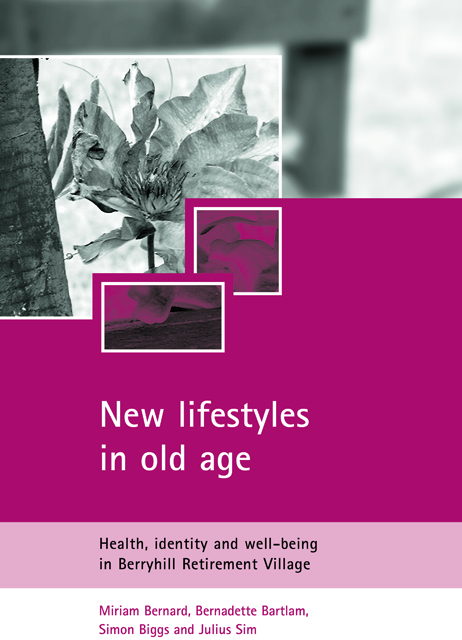Book contents
- Frontmatter
- Contents
- List of tables and figures
- Acknowledgements
- A day in the life of a retirement community resident
- 1 Retirement communities: the context
- 2 Developing a retirement community lifestyle: participation and involvement
- 3 Health and well-being
- 4 Growing older: age and identity
- 5 Conclusions
- References
- Appendix A Research questions
- Appendix B The study’s timeline
- Appendix C Questionnaires
- Appendix D Interviews
- Appendix E Participation groups and community conferencing
5 - Conclusions
Published online by Cambridge University Press: 06 April 2023
- Frontmatter
- Contents
- List of tables and figures
- Acknowledgements
- A day in the life of a retirement community resident
- 1 Retirement communities: the context
- 2 Developing a retirement community lifestyle: participation and involvement
- 3 Health and well-being
- 4 Growing older: age and identity
- 5 Conclusions
- References
- Appendix A Research questions
- Appendix B The study’s timeline
- Appendix C Questionnaires
- Appendix D Interviews
- Appendix E Participation groups and community conferencing
Summary
Introduction
In this concluding chapter, we first provide a brief overview of the main findings from the study. Although the research lasted for three years, it is important to stress that it is not, and cannot be, a definitive and conclusive piece of work – Berryhill Retirement Village was in existence before the study began, and will continue to evolve and develop long after we have left. In other words, the study provides insights – from one particular time period – about what it is like to live and work in such an environment. That said, there are a number of wider implications of these findings for others who might wish to develop similar forms of accommodation and care for older people in the future. This discussion is therefore organised around five different areas:
• the nature of retirement communities in Britain;
• what’s in a name? – terminology and attitudes;
• accommodating diversity;
• staffing such environments;
• links with the outside world.
Given that a key feature of the study was the close involvement of older people as active participants in the research process, the chapter concludes with a brief look at the impact the research has had on those with whom we worked.
Improving the lives of older people
Essentially, this study has enabled us to examine the contribution that one new model of accommodation and care can make to improving the lives of older people. In exploring the wider implications, it is important to remember that Berryhill was located in a deprived urban area that was significantly below the national average on key indicators for health and well-being. The village itself was large compared with more traditional accommodation and catered for, on average, 160-75 residents at any one time. As we saw in Chapter 1, residents were exclusively white, women outnumbered men in a ratio of 2:1 and the majority of residents lived alone, often because they had been widowed. The average age of village residents was between 75 and 76 and, from answers to the questionnaires, it was clear that health-related issues (affecting oneself or one’s partner) were the prime reason that people had moved into the village. From our qualitative work, it was also evident that people were anticipating that their health might become an issue for the future.
- Type
- Chapter
- Information
- New Lifestyles in Old AgeHealth, Identity and Well-being in Berryhill Retirement Village, pp. 50 - 58Publisher: Bristol University PressPrint publication year: 2004

